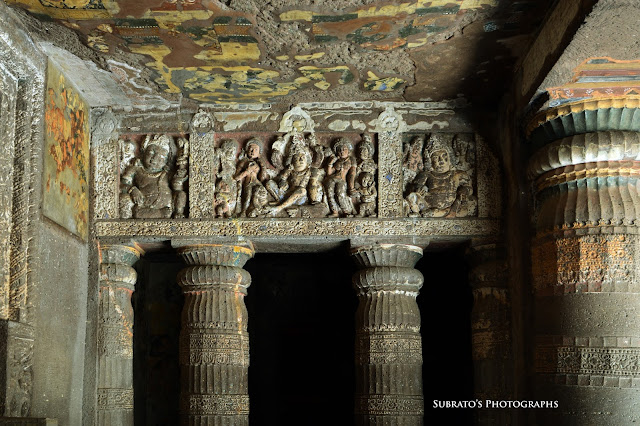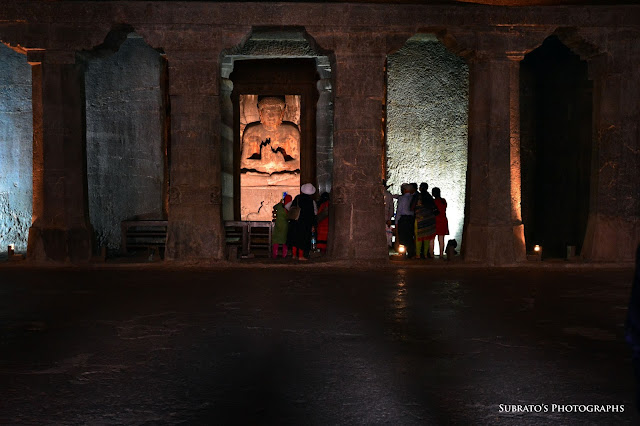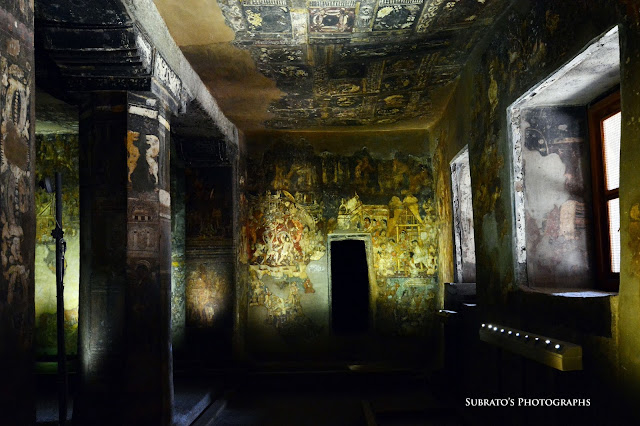Ajanta: The Great Ancient Picture Gallery
Not being an artist or a historian has always
been a handicap. My travels to different parts of our country have amazed me
and when I tried to express my thoughts, often found myself short of words.
Visiting Buddhist rock-cut cave temples and
monasteries of Ajanta was a very old dream. And, here we were at the foot of the
famous horse-shoe shaped cliff. I, along with my wife and son, climbed quite a
few difficult stone steps to reach up and could see the cluster of caves carved
in front.
From a distance, the caves generally appear unimpressive, some of them look unfinished and rugged from
outside. But as soon as we entered the first cave, we were totally vanquished by the
majesty and solemnity inside. The sight was surreal, an experience beyond
words. A flood of questions automatically raise their head in mind: who could
have built them, how and why? Who could have been crazy enough to hire hundreds
of workers for decades to create these wonderful monuments? What drove the
artisans? One thing that is certain that everyone involved surely was an
optimist. The ruler-financier whose vision these were or the designer-artists
who put long hours in pursuit of their dreams–every one of them were surely a
dreamer, a perpetual optimist. They must have spent all their youth and middle age
just carving a piece of the cliff hoping to create an ageless art. And, truly
ageless these are.
An archaeological marvel such as Ajanta is a fitting example of the unlimited human ambition and capability. The extraordinary wall paintings of Ajanta have no parallel anywhere. Each cave is filled with sculptures or delicately carved columns, wall murals and ceiling paintings. Though portions of many caves are damaged or destroyed, what remains of Ajanta has allowed a glimpse into the artistic traditions of ancient India. But how these exquisite murals were created on every inch of cave walls? Caves inside are dark, torches or oil lamps were definitely not in use because whole roofs too are painted with various patterns. Only way possible seems is an elaborate arrangement of mirrors to trap sunlight and reflect the same inside.
An archaeological marvel such as Ajanta is a fitting example of the unlimited human ambition and capability. The extraordinary wall paintings of Ajanta have no parallel anywhere. Each cave is filled with sculptures or delicately carved columns, wall murals and ceiling paintings. Though portions of many caves are damaged or destroyed, what remains of Ajanta has allowed a glimpse into the artistic traditions of ancient India. But how these exquisite murals were created on every inch of cave walls? Caves inside are dark, torches or oil lamps were definitely not in use because whole roofs too are painted with various patterns. Only way possible seems is an elaborate arrangement of mirrors to trap sunlight and reflect the same inside.
The modern story of Ajanta caves started on 28
April 1819, when these were accidentely discovered. It must be a very hot day when John Smith, an officer of 28th Cavalry of
the Madras Presidency chanced upon the Ajanta Caves (he actually found the cave 10) while on a tiger hunt.
Before that for over 1,400 years, the cave temples of Ajanta lay forgotten,
existing in oblivion. Once found, they soon become toast of historians. Some
believed that work on Ajanta started about two thousand years ago. The work on
the caves ceased around 650 AD. Guide books prosaically inform that the caves
were built in two phases starting around the 2nd century BC, with the second
group of caves built around 400-650 AD.
Many ancient historic sites in India are situated on trade routes. Is this true about Ajanta too? Historian and scholar, late Prof. D.D. Kosambi, suggests that the caves in the Western Ghats, from Shudhaghar, through Karla, Bhaja, Nasik, Pitalkhora, to Ajanta are located on the crests of an ancient trade route from the Arabian Sea in to the Deccan.
Many ancient historic sites in India are situated on trade routes. Is this true about Ajanta too? Historian and scholar, late Prof. D.D. Kosambi, suggests that the caves in the Western Ghats, from Shudhaghar, through Karla, Bhaja, Nasik, Pitalkhora, to Ajanta are located on the crests of an ancient trade route from the Arabian Sea in to the Deccan.
The paintings here have mesmerized many for ages.
Historian A L Basham noted in his book ‘The Wonder that was India’, “Here are
princes in their palaces, ladies in their harems, coolies with loads slung over
their shoulders, beggars, peasants and ascetics, together with all the many
beasts and birds and flowers of India, in fact the whole life of the times.
Everything is gracefully, masterfully drawn and delicately modeled.” The Ajanta
murals tell the Jataka stories (stories of lives of the Buddha) with supreme
elegance and grace. When some of the Ajanta paintings were first published in
the Transactions of the Royal Asiatic Society in 1829, historians
hailed them as precious fragments of a lost classical world. Acclaimed writer and historian William Dalrymple aptly calls it as ‘the greatest ancient picture
gallery’.
One can see the remains of famous Ajanta
paintings in caves numbered 1, 2 and 17. Though only few of them survive. Even
today, the colors of these murals glow with a brilliant intensity: topaz-dark,
lotus-blue, lizard-green. Cave 26 is the only one with the sculpture of a
reclining Buddha. This floor-to-ceiling sculptures of Lord Buddha, is
surrounded with many small and medium sized other statues. Sculptures of Lord
Buddha, some in Padmasana and a few in standing erect positions—found in quite
a few caves—are awesome. The every painting here has its own language and
communicates differently to each visitor. The paintings must have been executed
after elaborate preparation of the rock surface initially and filled with a
unique combination of earthen or vegetable colours.
Flashguns and camera stands are not allowed
inside the caves. Only small lead lights are provided in few caves to help see
the murals and paintings. Photography is tricky. Only positive is super-sensitive sensors of modern digital cameras.
The few images shared here are only pale reflection of the glorious Ajanta.
The few images shared here are only pale reflection of the glorious Ajanta.
Useful links:
http://www.nybooks.com/articles/2014/10/23/greatest-ancient-picture-gallery/
http://www.thelivingmoon.com/43ancients/02files/India_Ajanta_Caves.html
https://www.google.com/culturalinstitute/exhibit/vignettes-of-ajanta-ellora/gRIUkUp1?hl=en-GB&position=24%2C9
http://www.ajantacaves.org/history/historians/
http://shodhganga.inflibnet.ac.in/bitstream/10603/75375/10/10_chapter%202.pdf
http://thingsasian.com/story/ajanta-cave-murals-unmatched-expressions-middle-age-art
https://www.youtube.com/watch?v=AMWWPYIgaZ0
https://www.livehistoryindia.com/forgotten-treasures/2019/04/28/how-ajanta-caves-were-rediscovered?fbclid=IwAR35XBcb-mpPEyMPcyMAlM-eeXjp2xAQsUYG51dNWLHbUKZv2S9j6S5O-yE
http://www.thelivingmoon.com/43ancients/02files/India_Ajanta_Caves.html
https://www.google.com/culturalinstitute/exhibit/vignettes-of-ajanta-ellora/gRIUkUp1?hl=en-GB&position=24%2C9
http://www.ajantacaves.org/history/historians/
http://shodhganga.inflibnet.ac.in/bitstream/10603/75375/10/10_chapter%202.pdf
http://thingsasian.com/story/ajanta-cave-murals-unmatched-expressions-middle-age-art
https://www.youtube.com/watch?v=AMWWPYIgaZ0
https://www.livehistoryindia.com/forgotten-treasures/2019/04/28/how-ajanta-caves-were-rediscovered?fbclid=IwAR35XBcb-mpPEyMPcyMAlM-eeXjp2xAQsUYG51dNWLHbUKZv2S9j6S5O-yE





























Comments